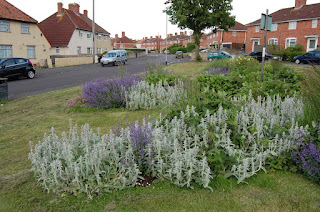Between 2001 and 2009 I worked on a series of plantings for Bristol City Council, some perennial borders in parks, but mostly roundabouts, traffic islands and junctions. The sort of places which thousands of people drive or are driven past every day. Traditionally these were planted up with bedding or with shrubs and mown grass.
People moved on, budget cuts bit, etc, so I haven't done anything in the city for few years now, although in fact council staff had told me that I had saved them a lot of money, one even telling me “we've not done any maintenance, and it still looks all right”. It was never the idea to do 'no maintenance' but I designed some very robust plant mixes, which have in fact coped pretty well.
Last week I was in Bristol over night and went out and photographed some of my work. I was amazed at just how much had not just survived but done really well. I felt very vindicated. Bristol offers fertile soils with a long growing season so weed competition can be severe. In most cases this was not a problem, with 'my' plants able to out-compete most weeds.
Levels of maintenance by council contractors varies. Smaller plantings in small parks are more likely to have a higher standard of care. Roadside plantings tend to have less. In some instances community groups have taken over and looked after plantings or in one case completely taken over to make a community-run area (Snuff Mills).
Three Lamps junction of the Bath and Wells roads
Very successful coverage by the plants chosen, but not a huge amount of colour. Partly perhaps because I just didn't photograph it at the right time, but also the stronger coloured Achillea definitely dies out whereas the paler survives. And there is a huge plant mix in here, so there's a long season of interest. What was good though was how complete the vegetation coverage over the soil is – denying space to weeds (and hiding the rubbish).
Oxford St – visible from the Wells Rd. just up from Three Lamps
This was intended as coppiced shrubs and perennials. No coppicing ever happened, and for some reason Geranium 'Claridge Druce' has taken over with a vengeance.Planting was done into a very thick layer of green waste, which over time has either degraded or been washed off, which did perhaps have a negative impact on some plants. This does show however just how well these pink geraniums do in the west of England climate. Long flowering season too. Few more of these and Bristol could be 'pink city'.
St. John's Crescent, Bedminster
A pocket park. Pretty well looked after this one.
Malago Lane, Bedminster
A triumph over adversity this. Nasty place to be a plant: salt, poor soil. A limited selection of toughies were planted, ALL species have survived. Rudbeckia fulgida greatly reduced but Euphorbia cyparissias does a fantastic job of filling spaces. Crambe cordifolia makes impact.
All very encouraging. The socialist in me loves doing this. Beautify the city. There are so many silly little patches of green all over Bristol, which all need mowing. They could all be planted up. It doesn't cost much. For a fraction of the money spent on the new gardens that our kleptocratic financier class seem to be busy making you could 'do' the whole city.
**********
Have you read the unique soap opera for gardeners – Dig, Plant and Bitch. Recently described by a colleague as 'Jilly Cooper meets Geoff Hamilton' (translation for non-Brits: sharp-nailed chicklit crossed with gardening advice from favourite uncle).










